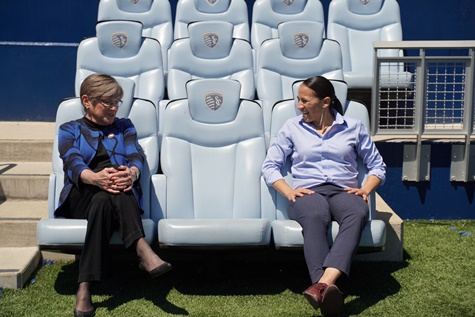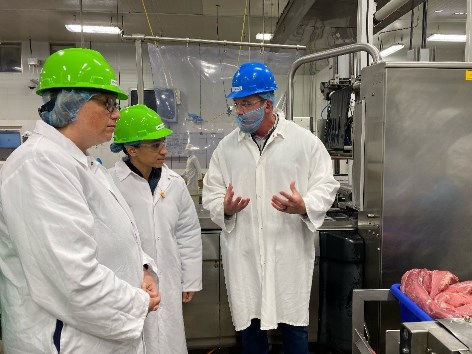Democratic lawmaker visits the Olathe home of Jerry Land, whose lead service line was recently replaced by the city
by Allison Kite, KCUR and Kansas News Service, a joint investigation by The Missouri Independent and the Midwest Newsroom
Olathe — The locations of lead service lines seem like the sort of thing someone would know, Congresswoman Sharice Davids said Thursday.
But as cities and counties across the U.S. grew, water utilities didn’t keep track of them all.
Now, they’re finally required to find them. The U.S. Environmental Protection Agency’s updated lead and copper rule requires utilities to create a lead service line inventory by October 2024.
Lead pipes — and infrastructure in general — is the sort of thing people don’t worry about until something has gone wrong, Davids said.
“That’s why it’s so important for us to be thinking about these infrastructure investments now so that in 50 years from now our children and grandchildren aren’t looking back and saying … why didn’t they take an inventory?” said Rep. Davids, D-Kansas.
Davids met Thursday with officials from local water utilities, the Environmental Protection Agency and Kansas Department of Health and Environment for an update on local efforts to inventory and replace lead service lines. And she visited the Olathe home of Jerry Land, a retired Teamster, where crews just replaced his lead service line.
Over the last six months, The Missouri Independent and NPR’s Midwest Newsroom have collaborated on a series of stories examining the issue of high levels of lead in children in Iowa, Kansas, Missouri and Nebraska.
Since lead was phased out of gasoline and prohibited from new pipes and paint, lead poisoning among children has plummeted. But the U.S. has not historically mandated widespread eradication of lead paint and pipes, so the danger remains, especially in the homes of poor and minority families.
Lead is a dangerous neurotoxin, and water is estimated to make up about 20% of a child’s lead exposure, according to the EPA.
The EPA banned new lead pipes in 1986 but never required utilities to thoroughly inventory their lead pipes before a crisis. Utilities have rarely been required to replace them under the federal lead and copper rule.
“This seems like the kind of thing where you’re like, ‘Oh, of course we would know,’ but with the ways that the cities have developed out, our county sometimes that information just is not readily available,” Rep. Davids said.
Now, the EPA is requiring utilities to find the lead lines — an estimated 5 to 10 million around the country — by 2024. And the bipartisan infrastructure bill approved by Congress last year includes $15 billion to replace them.
Davids worked on the bill as vice chairwoman of the transportation and infrastructure committee.
She said local, state and federal officials told her about efforts to spread the word on lead service line replacement to hard-to-reach communities and the timeline for completion of the inventories due in just over two years.
It’s unclear how many lead service lines might remain in Kansas, but Jeffery Robichaud, water director for EPA Region VII, estimated it was at least 150,000, meaning hundreds of thousands of Kansans may be drinking water from those pipes.
Efforts to replace them are already underway in Olathe.
Land’s 100-year-old home was among the first in the city to have its lead line replaced. Land has lived there since the mid 1990s, and his late wife owned the house before.
The city sent Land and other homeowners in Olathe’s disadvantaged communities a letter notifying them of the lines, said Megan Spence, the city’s distribution compliance manager.
Land didn’t realize the lead line was there.
“I really didn’t know any different,” Land said. “I didn’t really tell any difference until they told me there could be lead…in it.”
He quickly agreed to have the lead line taken out. He said the city quickly removed it and replanted the grass they dug up a few days later.
“I was kind of worried a little bit, so I said, ‘Yeah, I want it out.’ ”
Unleaded is a joint investigation by The Missouri Independent and NPR’s Midwest Newsroom exploring the issue of high levels of lead in children in Iowa, Kansas, Missouri and Nebraska. See https://www.kcur.org/news/2022-08-11/kansas-congresswoman-sharice-davids-touts-federal-funds-for-lead-line-replacement
Kansas Reflector stories, www.kansasreflector.com, may be republished online or in print under Creative Commons license CC BY-NC-ND 4.0.
See more at https://kansasreflector.com/2022/08/11/kansas-congresswoman-sharice-davids-touts-federal-funds-for-lead-pipe-replacement/


